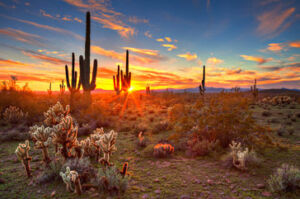The United States is blessed with such a variety of climates, it’s a challenge just to experience them all; from the frozen tundra of Alaska, to the magical waving palms of Hawaii, to the sultry tropical feel of the southern states, the breezy New England shores, and the arid and amazing desert of the Southwest. Set a travel goal for the next five years to visit each of these locales and savor the astounding natural wonders that lie within.
Unlike any other part of the US, the deserts of the Southwest hold astonishing flora and wildlife that thrive in its harsh climate. Try to visit these National Parks in early morning or as night is falling, when the animals are more active. A bonus: the light is softer at these times, making for more stunning nature photography.
This National Park was established in 1919, and is over 10 miles wide and a mile deep. Layered bands of red rock reveal millions of years of geological history, as the Colorado River winds along its 277 mile length. Walking, hiking and boating are the best ways to view this one-of-a-kind wonder.
This magical place in Far West Texas is stunning with its canyons carved from limestone eons ago. The best ways to take in the landscape and wildlife are through day hikes, biking, scenic drives or river trips. The diversity of species that call this place home is astonishing; try to experience the enchantment of the night, when the stars glow brilliantly against the deep black velvet of the sky.
Named for the twisted, spikey trees that populate this desert enclave, this National Park is composed of two distinct desert ecosystems, the Mojave and the Colorado. Few areas in the world demonstrate the difference between “high” and “low” desert ecosystems as clearly as can be seen at Joshua Tree. Although the climate is brutal at times, a vast array of plants and animals thrive here, and Native Americans traveled this route in search of pinyon nuts, acorns and cactus fruit, leaving behind rock paintings and colorful pottery to mark their passing.
Despite its morbid name, a vast array of animals and plants thrive in this low-lying desert basin, 282 feet below sea level. With the highest-recorded temperature on Earth, occasional rains burst forth fields of wildflowers, and Telescope Peak is snow-covered most of the year. In this land of extremes, over 400 species of native wildlife not only survive but thrive.
To the east and west of Tucson is Saguaro National Park, populated with the nation’s largest cacti and symbol of the west: the giant saguaro. The two districts of this national treasure offer over 165 miles of hiking trails; from an easy stroll on a short interpretive nature trail to day-long adventures into the back country. A hike to the Rincon Mountain district offers spectacular scenic overlooks.
Experience the beauty of this nature preserve in Southwest Utah. Zion Canyon’s 2,000 foot red sandstone cliffs majestically frame the Virgin River that flows to the Emerald Pools, where waterfalls and hanging gardens delight the senses. Over 1000 plant species and 207 bird species inhabit this desert wonderland.
No matter where you travel, let All Star Travel be your first stop for great prices on lodging, rental cars, cruises, resorts and more. Join our free travel club today and receive exclusive offers tailored to our members. We promise to deliver outstanding customer service, and to help support our community as well. For more information on our National Parks and other top destinations, visit our blog often.
